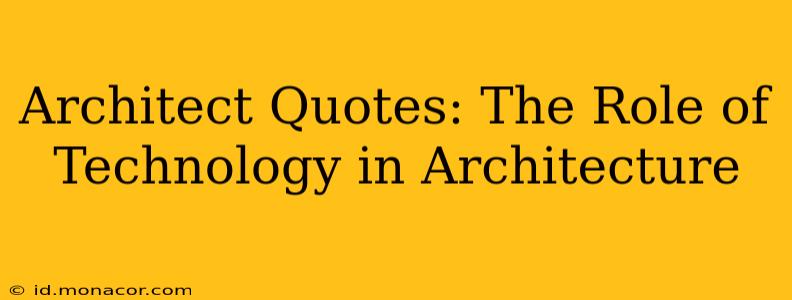The architectural landscape is constantly evolving, driven by technological advancements that reshape design processes, construction methods, and even the very nature of buildings. From Computer-Aided Design (CAD) software to Building Information Modeling (BIM) and 3D printing, technology's influence on architecture is undeniable. Let's explore this fascinating intersection through the lens of insightful architect quotes and a deep dive into the impact of technology on the field.
How Has Technology Changed Architecture?
Technology has revolutionized architecture, shifting from drafting boards and hand-drawn sketches to sophisticated digital tools. This transformation has significantly impacted every stage of the design and construction process, leading to increased efficiency, improved collaboration, and the creation of innovative building designs previously unimaginable. We've moved from purely physical models to virtual realities, allowing for better visualization and client interaction.
What Are the Benefits of Using Technology in Architecture?
The benefits are multifold. Improved accuracy and precision are paramount. Technology minimizes errors in design and construction, saving time and resources. Enhanced collaboration is another key advantage; BIM, for instance, facilitates seamless information sharing among architects, engineers, and contractors, leading to a more streamlined workflow. Furthermore, technology allows for the exploration of complex geometries and sustainable design solutions, pushing the boundaries of architectural creativity. Finally, the visualization capabilities of technology enhance client engagement and understanding of the project.
What Software Do Architects Use?
Architects utilize a range of software, each with its strengths and weaknesses. CAD software remains a staple, providing tools for 2D and 3D modeling. BIM software like Revit and ArchiCAD takes this further, creating a digital representation of the building that includes all its components and data. Other popular tools include rendering software (like V-Ray and Lumion) for creating photorealistic visualizations and simulation software for analyzing energy efficiency and structural performance. The specific software used often depends on the project's scale, complexity, and the architect's preferences.
What Are the Challenges of Using Technology in Architecture?
Despite its numerous benefits, technology presents challenges. The initial investment in software and training can be substantial. The complexity of some software can lead to a steeper learning curve for architects and their teams. Furthermore, data security and management become increasingly critical as digital models store vast amounts of sensitive project information. Finally, the reliance on technology can sometimes overshadow the importance of human creativity and intuition in the design process. A balance needs to be struck between leveraging technology's potential and maintaining the artistic essence of architecture.
What is the Future of Technology in Architecture?
The future of technology in architecture is bright, with exciting possibilities on the horizon. We can expect further integration of Artificial Intelligence (AI) and Machine Learning (ML) in design and construction management. Virtual and Augmented Reality (VR/AR) will likely become even more prevalent, improving client communication and enhancing the design experience. Advances in 3D printing and robotic construction could revolutionize building processes, enabling the creation of complex and customized structures with greater speed and efficiency. The integration of smart building technologies will also be crucial, enabling the creation of sustainable and responsive environments.
Conclusion
Technology's role in architecture is not merely an enhancement but a fundamental shift in how buildings are designed, constructed, and experienced. While challenges remain, the potential benefits are immense, shaping a future where technology empowers architects to push creative boundaries and build a more sustainable and innovative built environment. By embracing technology responsibly, architects can combine human ingenuity with technological advancements to create truly remarkable structures.

